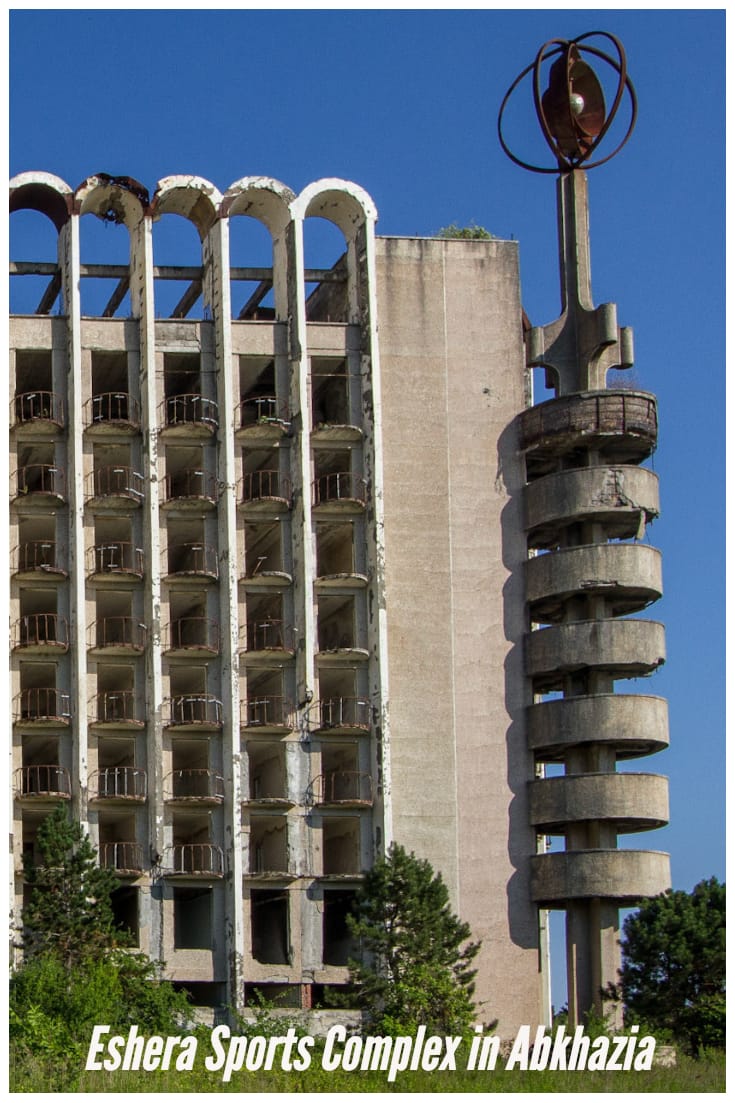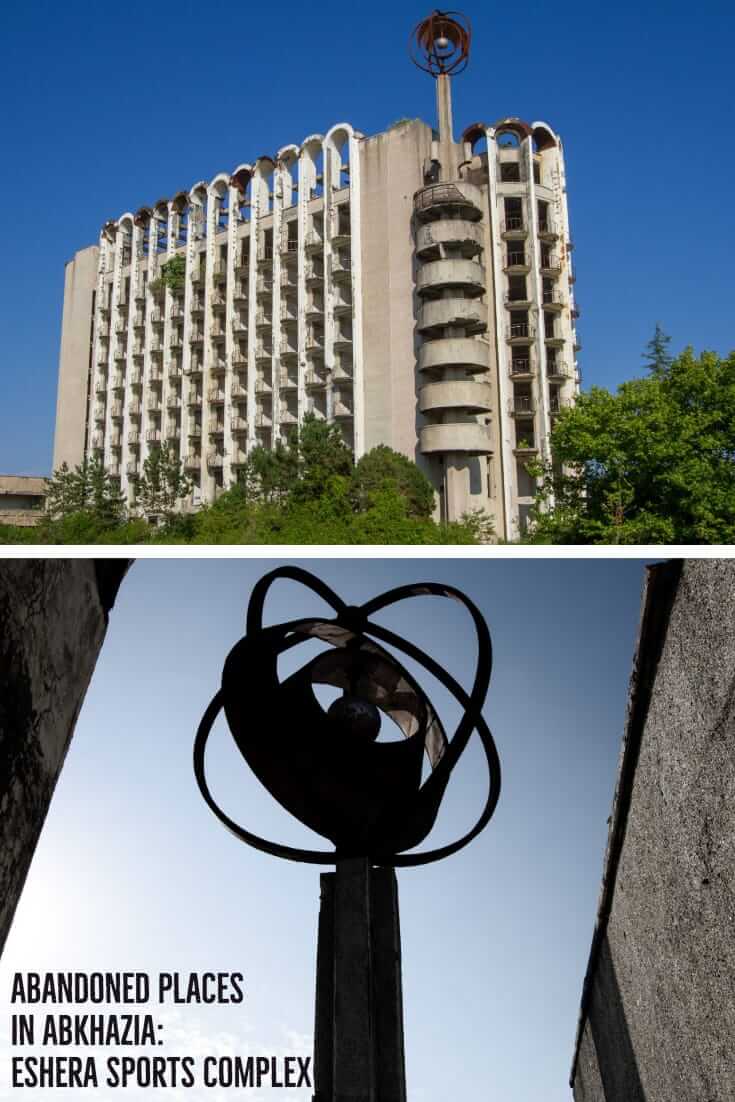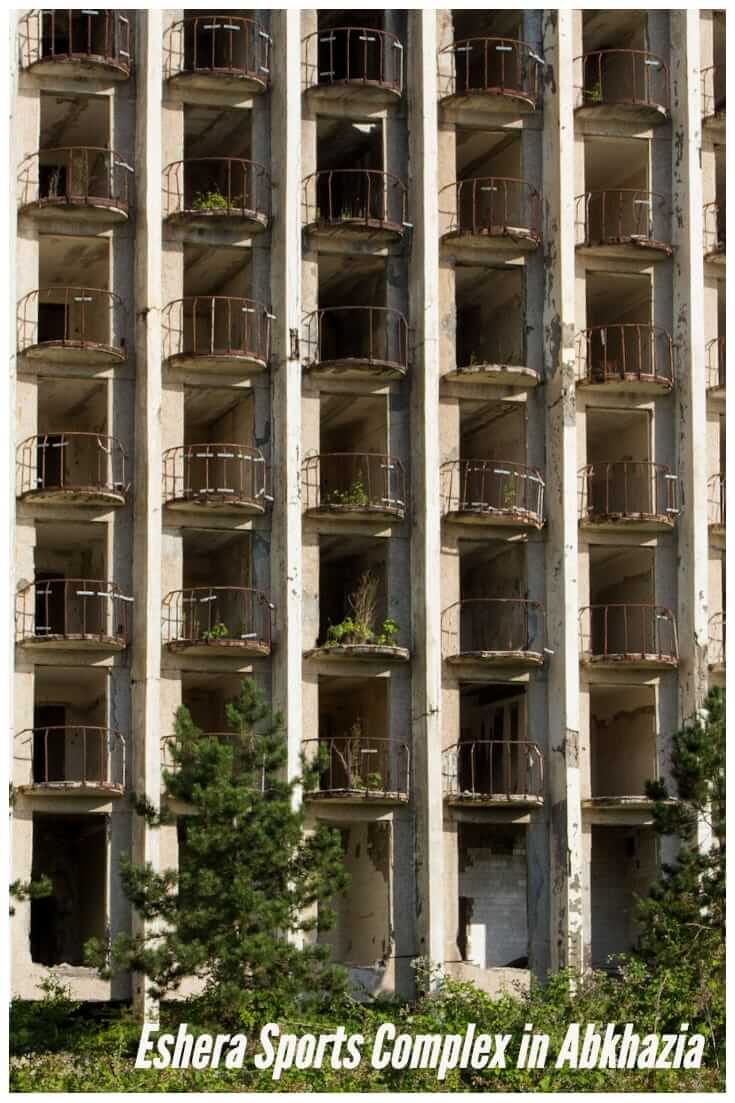Exploring the ruins of the former Central Olympic Base of the USSR on the outskirts of Sukhumi
There’s isn’t much left of what used to be the Eshera Sports Complex, the former Central Olympic Base of the USSR. Like so many buildings of note in Abkhazia, it was ravaged during the Abkhazia-Georgia conflict which took place between August 1992 and September 1993.
What remains is a number of hulking shells, including the main structure with its distinctive spiral tower, the swimming pool, restaurant and gymnasium. All of them have been stripped of anything of value a long time since.
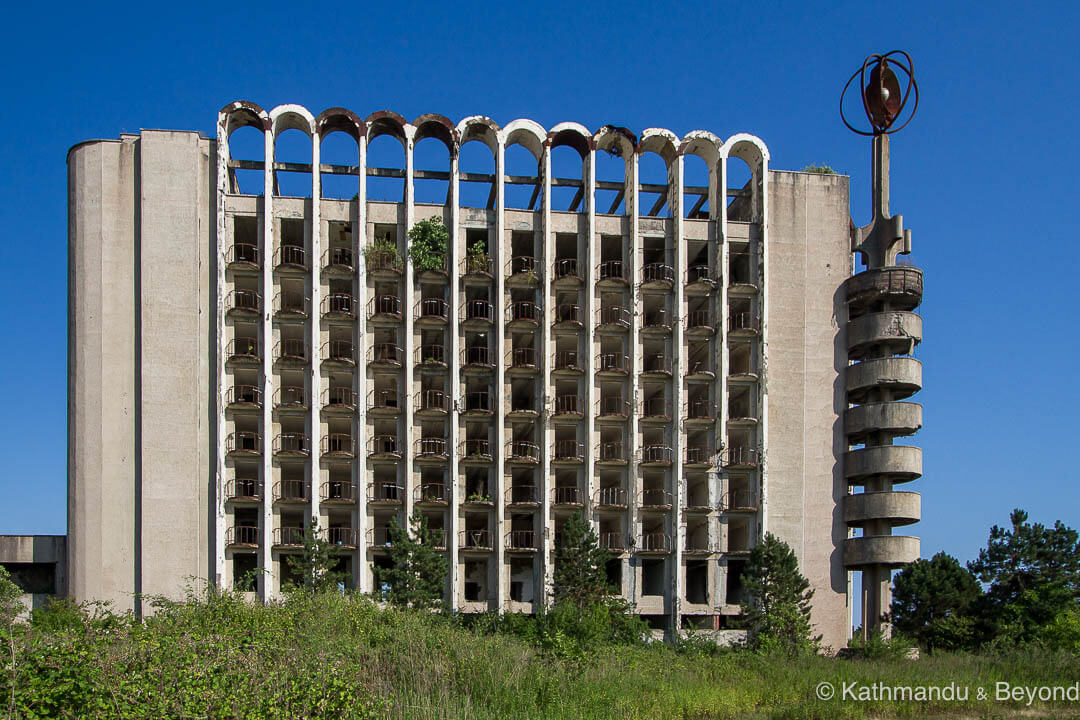
Hotel and living quarters for the athletes
The concept of one location, where athletes from Russia and the Soviet republics could come together and train, and sometimes compete, was originally conceived in the 1960s but it wasn’t until the 1970s and ‘80s that work on the complex started to evolve. And even right up until the beginning of the 1992-93 war, the base was still being developed and additional facilities added.
Eshera, also spelt Escher or Esher, an oversized village a short distance west of Sukhumi, was presumably chosen as the site of the Olympic sports centre because of its pleasant Black Sea location. Many people from the village worked at the site and it was good for the local economy.
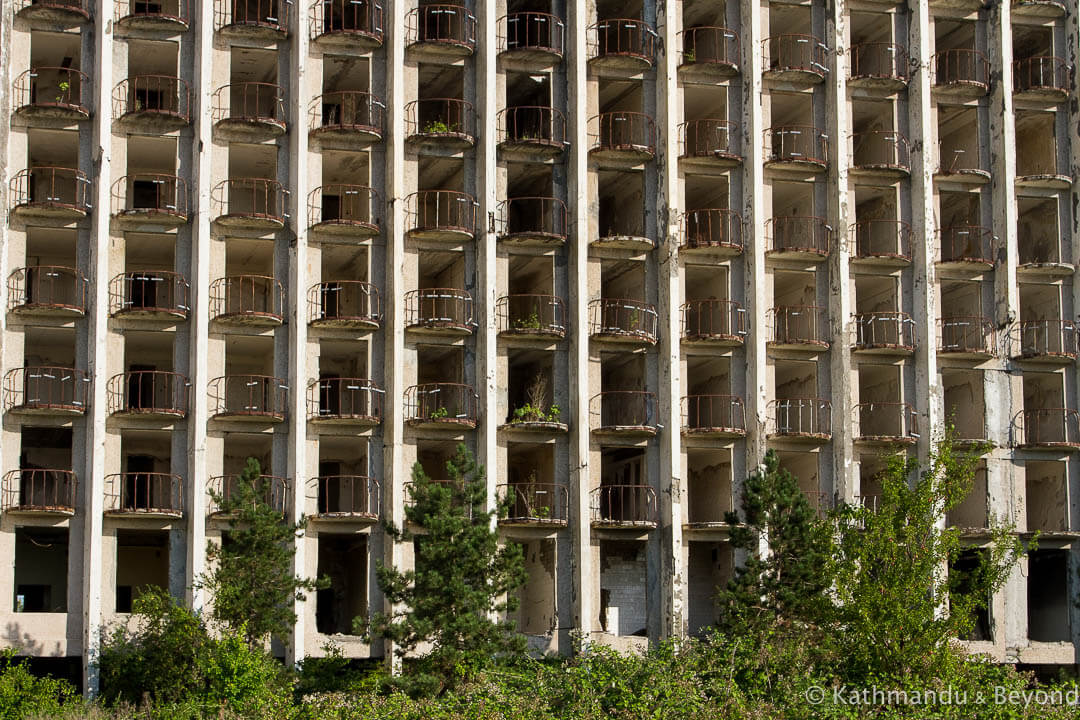
Hotel and living quarters for the athletes
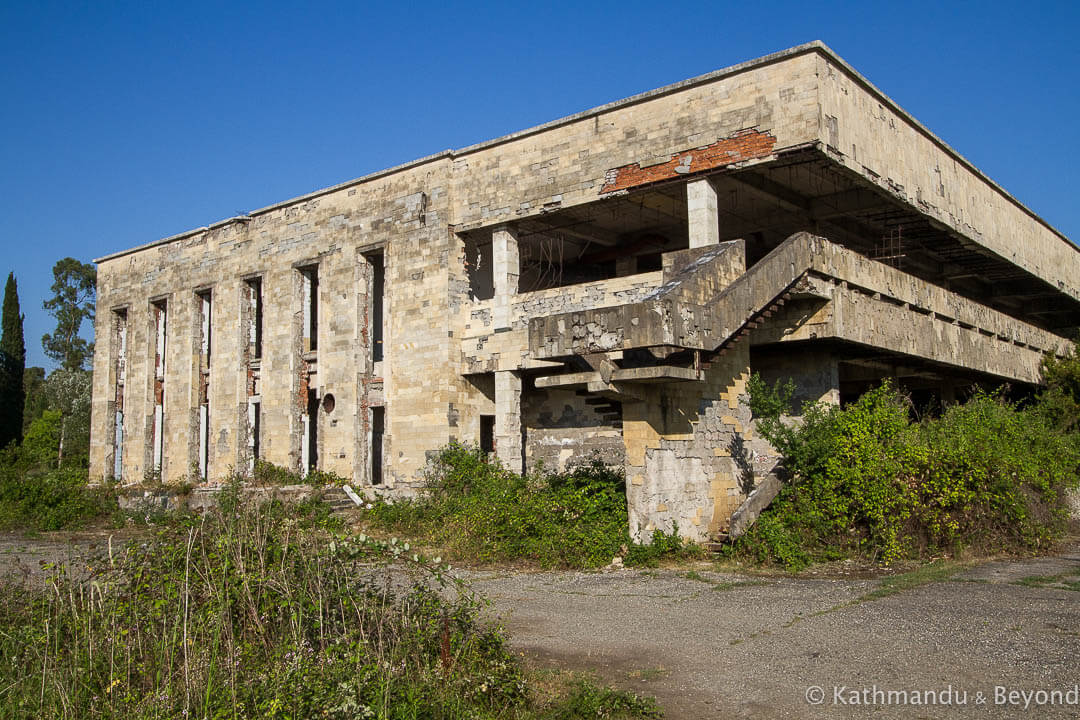
Restaurant
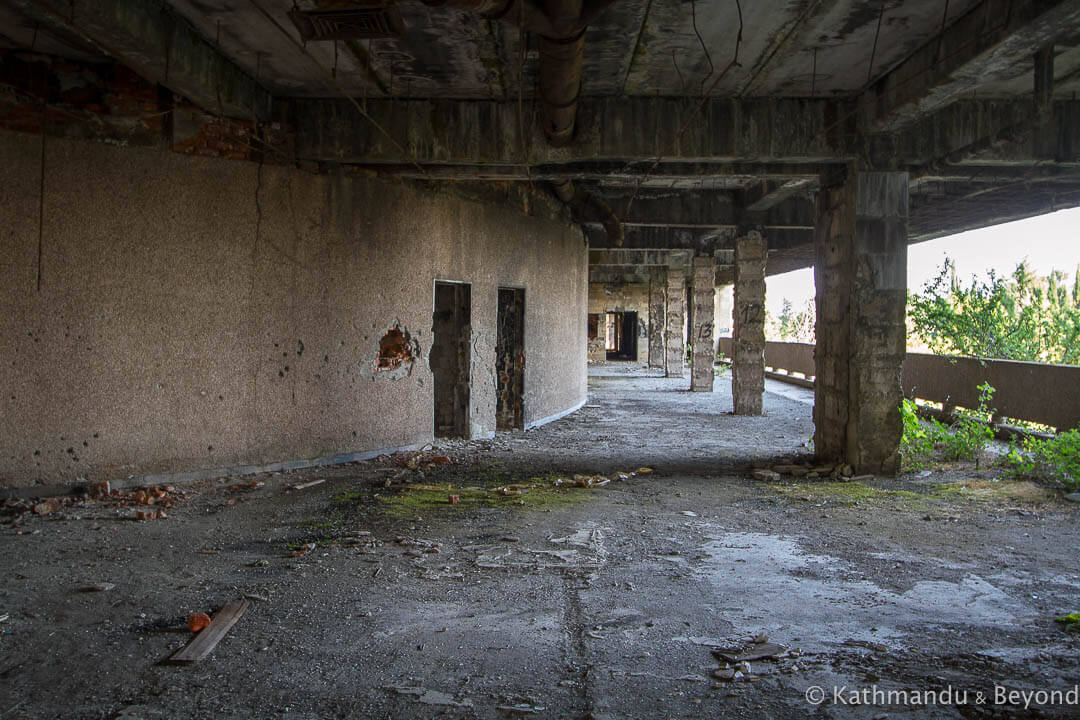
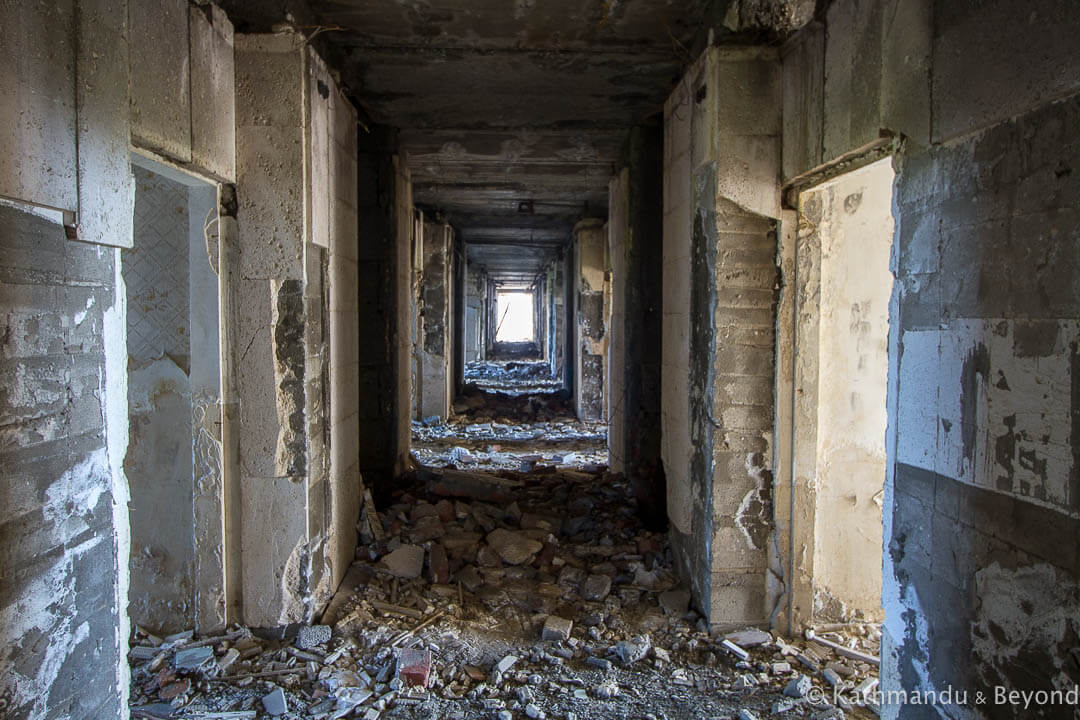
Restaurant terrace (left) and internal corridor (right)
At its height, the Central Olympic Base of the USSR was one of the most important multi-sports training centres in the entire Soviet Union. There were facilities for more than forty activities including four football pitches, basketball courts, running tracks, a huge gymnasium, and a 50-metre Olympic-size swimming pool. Well known Olympians, as well as other sportsmen and sportswomen, from all corners of the USSR were a common sight, and the venue even hosted a meeting of the Swiss-based International Olympic Committee (IOC). Many of the athletes who took part in the famously-boycotted 1980 Summer Olympics, which were held in Moscow, trained at the Central Olympic Base of the USSR in Eshera (*).
(*) Even though I was only twelve years old, I remember the 1980 Olympics very well as it was during this time that I got my first crush. When I was six years old I had a run-in with an escalator at Waterloo train station in London. I badly damaged my left hand and the long and short of it was that I needed thirty-six stitches in the hand and spent a lot of time in hospital. As part of my recovery, I had regular physiotherapy sessions and my physiotherapists suggested to my parents that I take up gymnastics in order to help strengthen the hand. I duly did so and got quite good at it. I represented my county (not my country!) on a number of occasions and, for a few years, spent part of my summer holiday at a gymnastics training camp. 1980 was one of those years and during downtime, most of us there watched the Moscow Olympics on the television, especially the gymnastics. Because of the boycott, the Soviet Union was wiping the floor in this particular event. Their athletes were good anyway but, without the Americans there, no other country came close to their medal tally (twenty-two in total versus eleven for second place East Germany) and they were a joy to watch.
And none more so than Nellie Kim, a Tajik-born gymnast who was not only an amazing athlete but also extremely pleasing to my preadolescent eyes. Although she was born in the Tajik Soviet Socialist Republic (now Tajikistan), her father was Sakhalin Korean (Sakhalin is an island just off the east coast of Russia) and her mother was a Tatar and I was well smitten by her exotic looks. The Moscow Olympics, in which she won two gold medals, were her last competitive performance (she was twenty-three) and, given this was pre-Internet days, I lost touch with her and, besides, not long after a girl named Heidi came along, but that’s a completely different story which I intend to keep to myself!
We visited the former sports centre late afternoon on a hot, sunny day in June 2018. As we approached along a bumpy backroad (we missed the turnoff for the main entrance), the first thing to come into view was the all-dominating nine-storey hotel and living quarters for the athletes. The complex accepted non-sports people and guests were put up in this building also. Nowadays, the interior is completely gutted and, as we made our way to the roof, we spotted several gaping holes in the outer wall that presumably were as a result of shell-fire during the conflict.
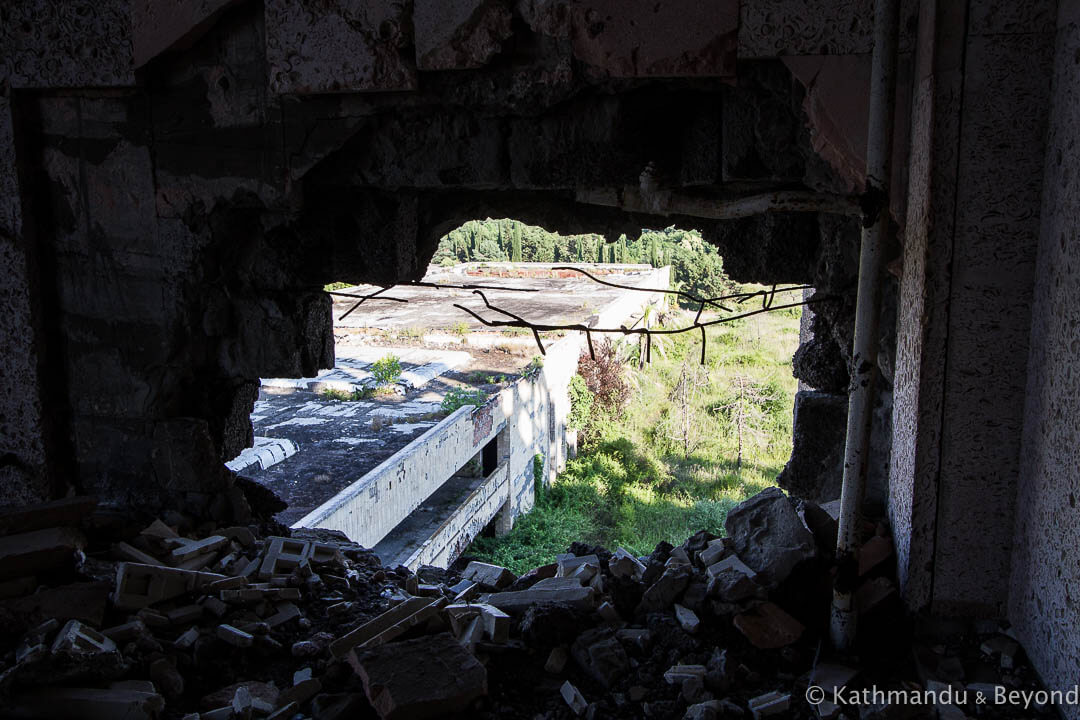
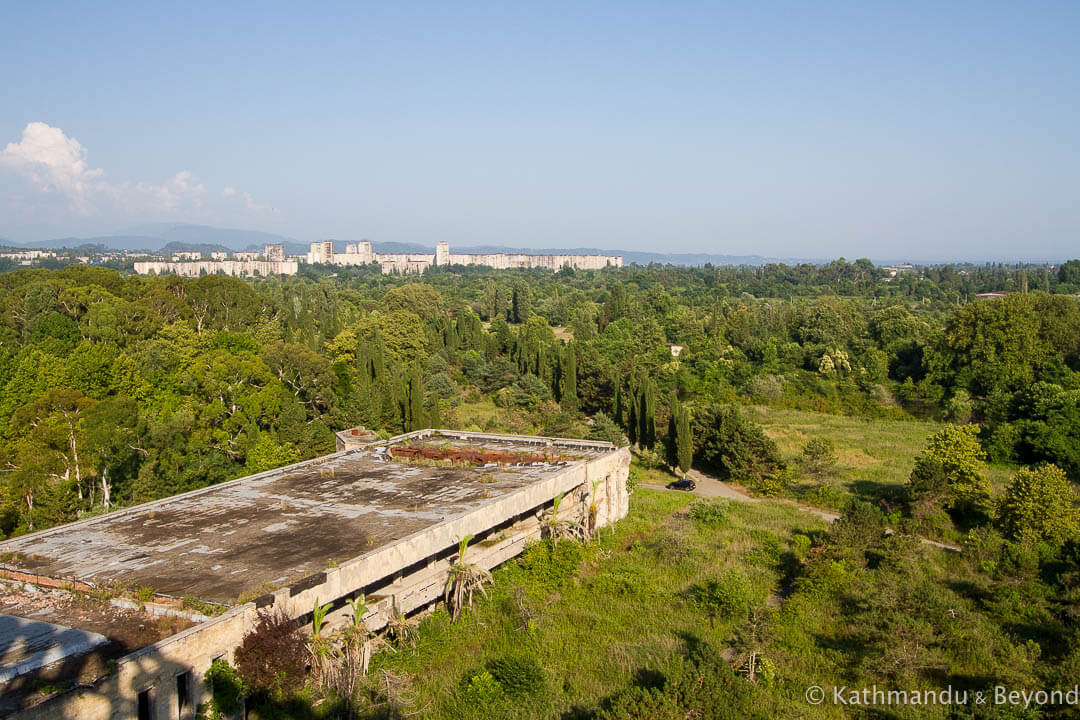
Looking down on the swimming pool and back towards Sukhumi
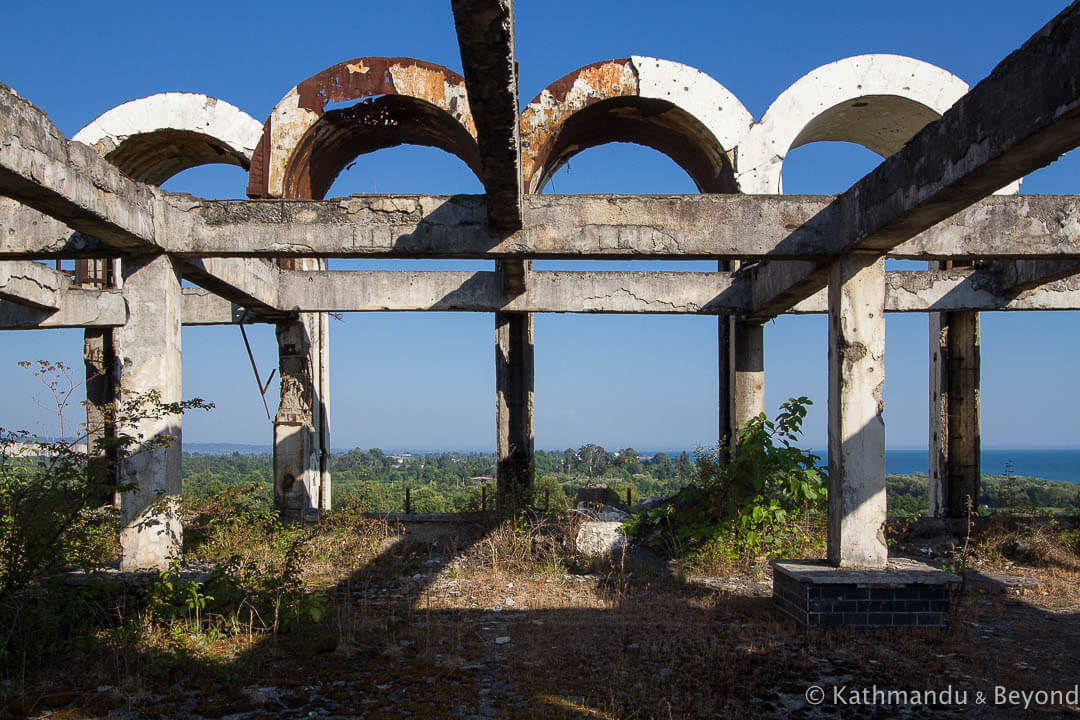
On the rooftop of the hotel and living quarters for the athletes
Once up high, the view of the Black Sea and back across to Sukhumi was magnificent and we noticed a handful of people down on the stony beach, either having a BBQ or frolicking in the water. As with the interior, there wasn’t much left on the rooftop either, although the emblem of the Olympic base was still intact on the building’s corkscrew offshoot.
Attached to the hotel was a large restaurant, which went through to, what looked like, a cinema and eventually the swimming pool. The latter was in a particularly bad state: the diving platforms had long-since rusted and the pool itself was full of stagnant water. The building echoed with the sound of croaking frogs and, as we made our way back to the car, a couple of cows passed us, presumably on their way to a better patch of grass for grazing.
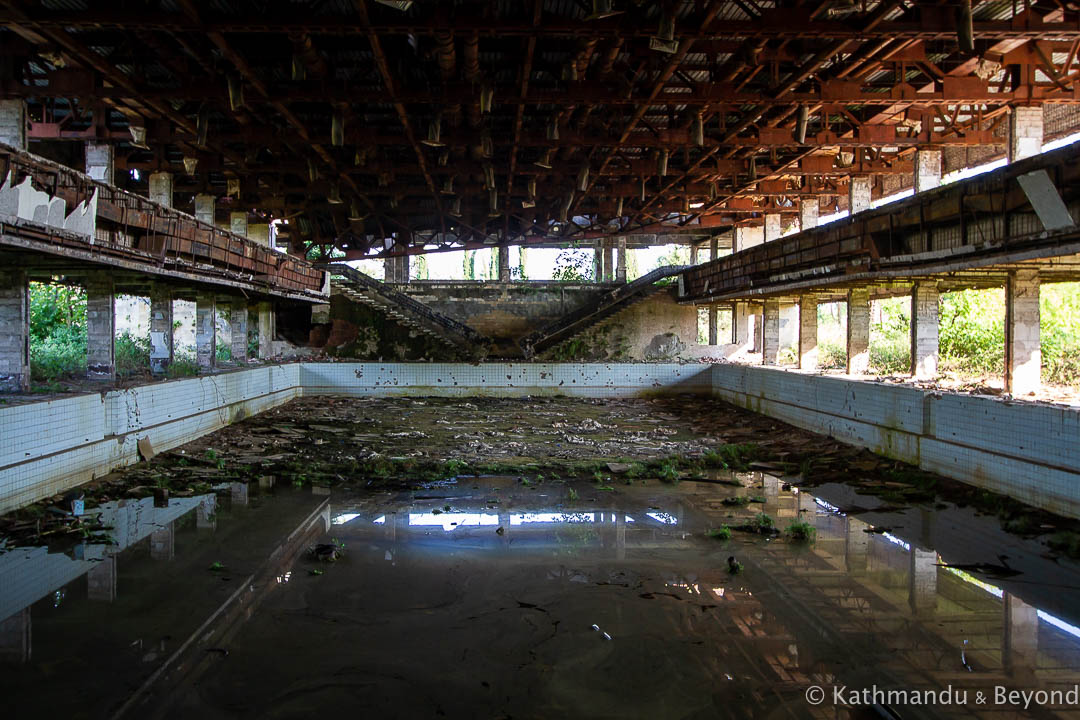
Swimming pool
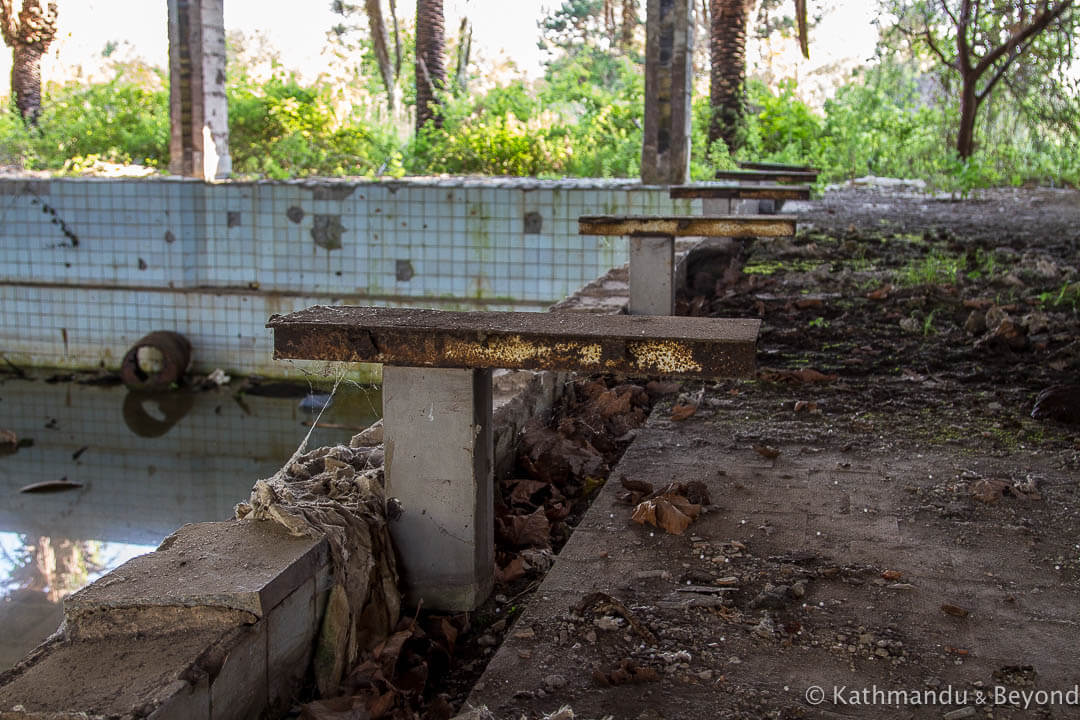
The starting blocks at the swimming pool had seen better days
We made one final stop before leaving for good and that was to see the gymnasium, which was situated a few hundred metres east of the main complex. We had seen photographs of this building on the Web and we were keen to see the large mosaic that featured on the front of the structure. The mosaic had clearly deteriorated since the people who took the photo had visited as it was in a terrible condition and the stairway that led up to the veranda, from where you could get a better view of it, was no longer in place.
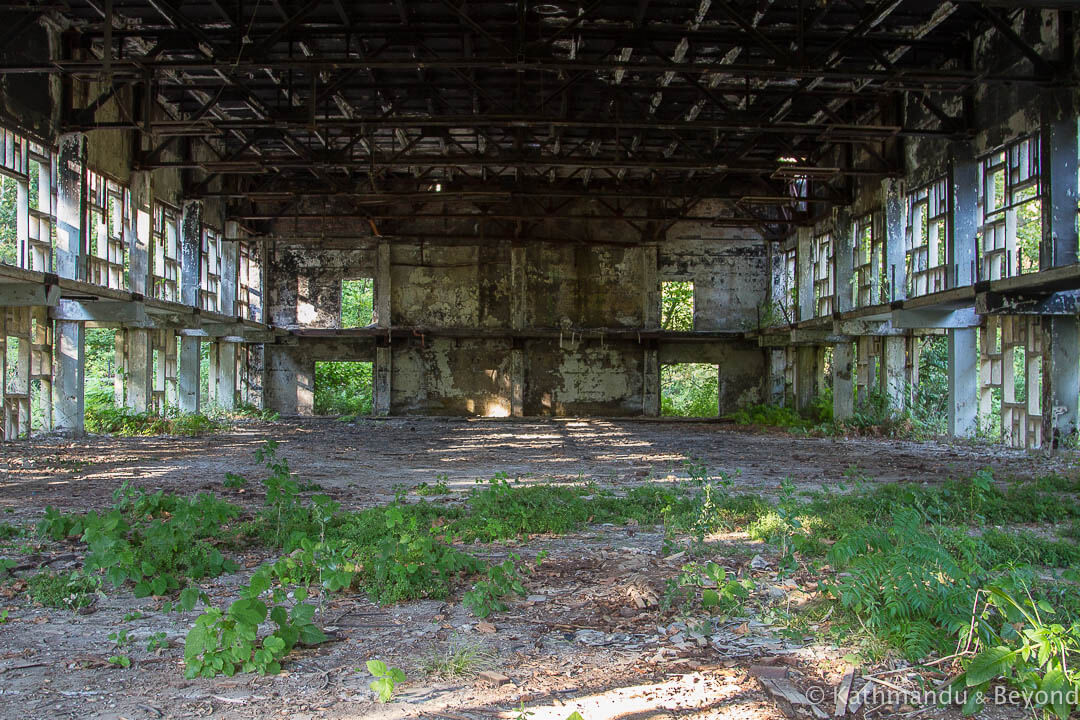
Interior of the gymnasium
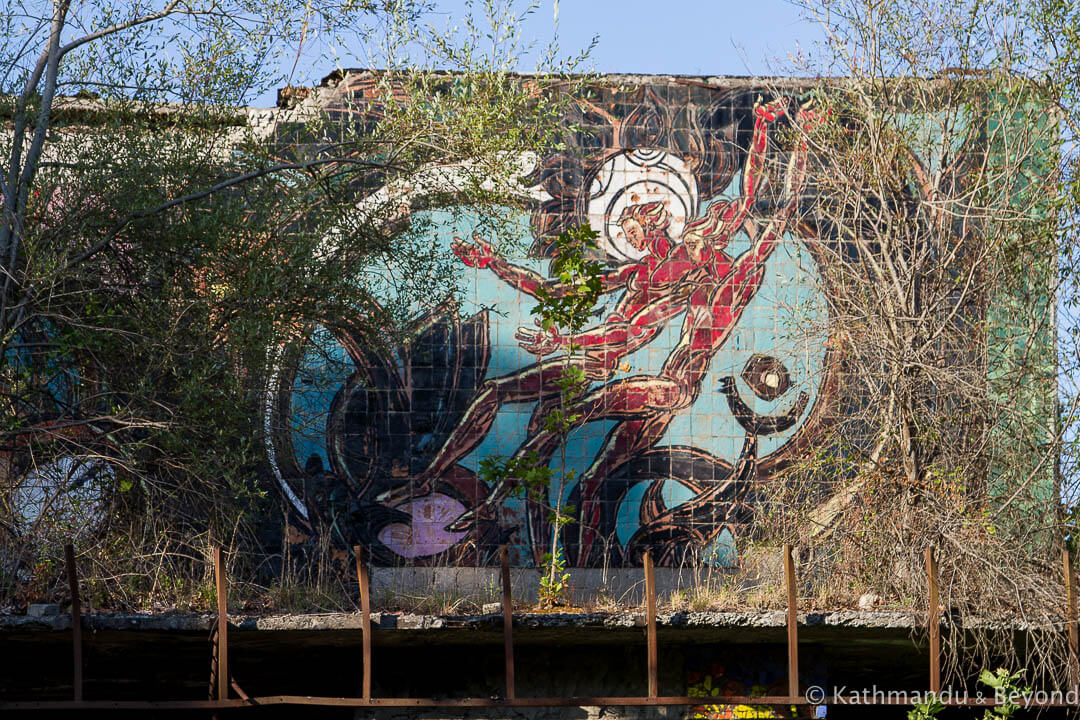
This was the best view we could get of the mosaic on the exterior of the gymnasium
As is often the case, I Google a location we have recently visited after the event to see if I can find out more about it. With Eshera Sports Complex, I did found one informative article on the online news site, Sputnik, which included interviews with the centre’s former directors, but mostly I only came across photo-based essays which didn’t contain a lot of information. But, what did attract my interest, however, were some of the comments attached to the photo essays. I had to translate them from their original Russian, but there were quite a few reflections from people who had visited the place during its heyday in order to train in their specific sport. One commenter recalls eating in the restaurant, which was ‘very big, noisy, light, with beautiful views from windows’. Another one recalls being there in 1984 when ‘everything was like a fairy tale, a swimming pool with the latest technology, a gym with the most modern simulators, and a medical cabinet as a spaceship’. Others mentioned being star-struck upon seeing their sporting heroes (‘I remember the basketball players because of their growth’). Most likely those who made the remarks were either children or teenagers at the time of their visit: an age bracket that, according to one comment, ‘were allowed to use only the stairs’ and not the elevators!
I also found one comment from a person who, along with his family, ‘spent the first 29 days of the war there (the main building)’. The commenter went on to say that his family were concerned about the home they had been forced to leave being plundered as ‘from the high building to our yard (it was no) more than one kilometre. Often, we fired upon our yard, if we saw people coming out into the yard, including children’.
This is the only reference I can find regarding the base being used as a place of refuge during the Abkhazia-Georgia conflict but, you have to assume that, if this guy and his family headed there to try and stay out of harm’s way then others did the same.
Currently, the sports centre and the land it is on belongs to the Abkhazian government. With Russian backing, of course, there have been discussions for near on a decade now about turning it back into a top-notch sports facility once more but, to date nothing has materialised and this vast and once-impressive vestige of the USSR stands isolated and empty. I was tempted to add that it sits there, a large blot on the landscape but, because of the war, Abkhazia has so many buildings in a similar condition that it would be unfair to highlight just this particular one.
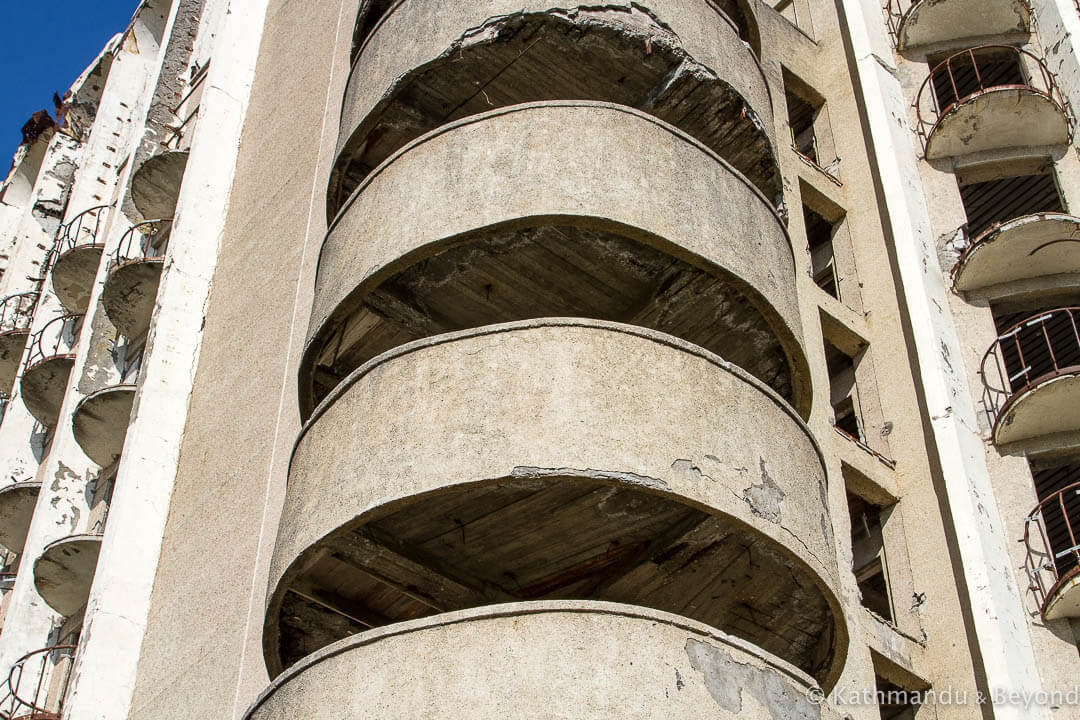
READ MORE BLOG POSTS FEATURING THE CAUCASUS REGION
READ MORE BLOG POSTS FEATURING ABANDONED PLACES
DO YOU ENJOY EXPLORING ABANDONED PLACES? PIN THIS TO ONE OF YOUR TRAVEL BOARDS…
